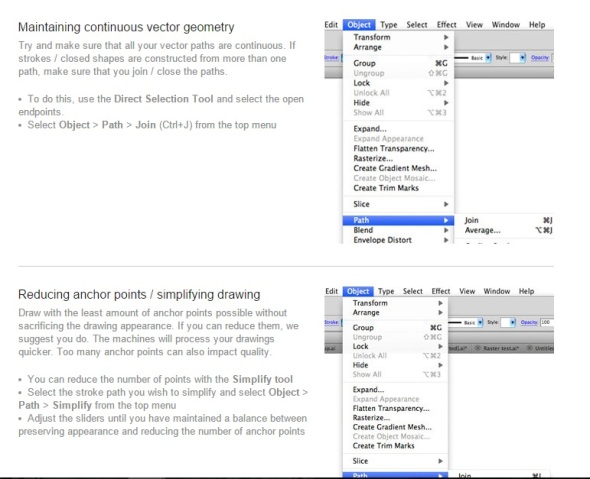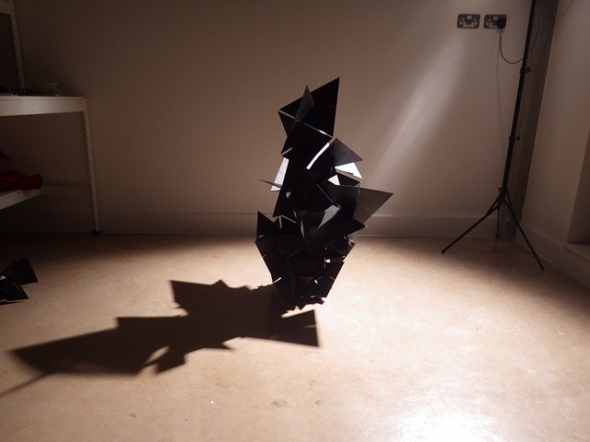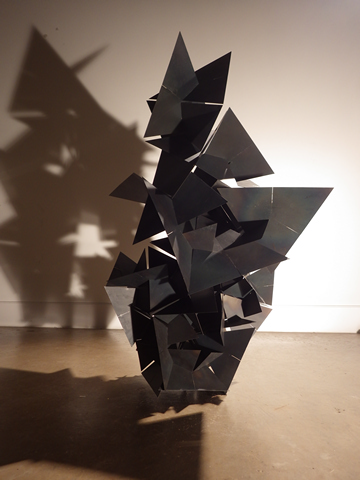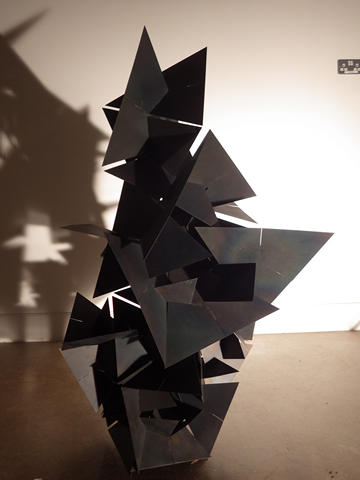Adhocism
Posted: March 9, 2016 Filed under: Subject Leave a commentMy work for my final show has evolved to focus on structural systems and surface as a means for producing sculpture that explores form, line and volume, spacial qualities and the transgression of an idea/data/structure through various forms, abstractions and focuses.
Whilst thinking on structural systems I thought of Adhocism. I attended a symposium called Ceramics and New Technologies, at the Holburne Museum on the 26th of February. There the artist Micheal Eden, the keynote speaker spoke about his interest in the history of the human hand, how it represented millenia of skills built upon by man. The nature of technology and craft – cultivation, trial and error, imagination and hard work followed. He spoke of platonic solids as building blocks of all matter, (in a specific context that I have since forgotten) which resonated with me particularly, for it relates well to my work. Then he spoke for several minutes about adhocism and its influences on his work, making an example of the bicycle as an example of work that is added to, build upon over time by many and eventually becomes as developed as it can be, one might dare to say almost perfect.I later found this image in the book Adhocism by Charles Jencks and Nathan Silver, it is titled ‘Evolutionary series of the bicycle’.

A few weeks later (from the symposium) and after a couple of conversations about structures, systems and ways of working with them I decided to conduct a super fast research session (timers, chocolate bar, the whole deal) to try and build a concise, clear idea of what exactly Adhocism is, its relevance to me and my work, and what it could teach me about how I make my work. so I have checked out the book Adhocism by Charles Jencks and Nathan Silver (1972, 2013) the expanded and updated edition from the library (the one Micheal Eden referenced in his talk at the bath symposium on ceramics and new technology) and got cracking.
Right, lets go…
Much of what follows will be quotes, paraphrasing and reflections. This is to be fast. So it might not make the most joyous of reading experiences…
Adhocism is -“a mongrel term first used in architectural criticism in 1968”
A conjunction of ad hoc -“for this particular purpose” and ism – short hand for a movement in the arts.
“Adhocism denotes a principle of action having speed or economy and purpose or utility, and it prospers like most hybrid’s on the edge of respectability.”
Basically, as in architecture, it involves using an available system in a new way to solve a problem quickly and efficiently.
A typical example of adhocism takes an existing system and adding new/different components/parts or systems.
“Perhaps 90% if adhocist concoctions are like this, old systems with a few supplementary clip-ons. ”
“A second point is that the visual result should looks complex or striking”
Then a list of points of what ‘good’ adhocist concoctions should show:
- What they do
- Where they came from, their past (the additions should be clear)
- How they are put together.
“Legibility and dissect-ability are are key exressive aspects of adhocism, they are goals in themselves for some.”
The third important point about adhocism is CREATIVITY.
The point of “to this specific purpose” troubled me a bit, when we consider this in relation to my work and the work I want to make does it run into problems? Ill have to think on that one.
(All of above from foreword page 7)
The books arguments follow the ideas of Arthur Koestler and others “who have long pointed out that all creativity depends on the coming together of disparate material”
My short research period is up, at some point soon I think I shall have to have another brief one. Adhocism is an incredibly interesting area/topic that I would love to revisit. It has many values that I see in my work or particularly in my process of working, but it also holds several that perhaps I don’t find in my work or process. When things refer to systems, structures, object histories and environment I feel a resonance and get excited, other aspects of the -ism I perhaps do not understand so well or feel so strongly connected with.
Laser Cutting a tower model
Posted: February 22, 2016 Filed under: Subject 3rd Year Leave a commentThese 1mm thick card components come together to form a simple tower that I designed on rhino with grasshopper. Using the Grasshopper plugin for Rhino I designed a quick, abstract strange shaped organic-ish column form that I then booleaned out of a simple rectangular column. This file went though 123D Make and Illustrator where I made a second deriving from the original. This is greatly abstracted and uses fewer pieces and is significantly larger. A post will follow showing the 2 complete towers.

GIF Experiments
Posted: February 19, 2016 Filed under: Subject 3rd Year Leave a commentAs part of my fast prototyping for sculpture ideas I decided to record the process of rapid model building. I thought I would like to make a ‘gif’ of the process. As I constructed the first circle system from laser cut 5mm cardboard. I took a photo as each module was added, as the structure began to grow. All of these photos were then opened in GIMP (open source version of Photoshop) each to its own layer, and then using the make gif function I set the frame rates I required and then it is exportable as a gif file. When opened in a photo viewer it automatically starts. It went smoothly, I quickly followed tutorials on youtube and seemed to know what I was doing pretty quickly. To each layer you can apply all sorts of effects, speed up and slow down the frame rate for individual frames and much more. I will be making more in the future I think.
Working with DFX files in Illustrator
Posted: February 19, 2016 Filed under: Subject 3rd Year Leave a commentTo get my files ready for laser cutting (those that have been sliced in 123D Make) I need to import them into Illustrator to set line widths and to scale, orientate the work and ensure the artboard is the correct size. I was having some problems with too many anchor points and too many un-closed lines. I trawled a few forums for solutions to little avail, other than to find many others experience these problems also. The fact is the file format and illustrator don’t seem to work terrifically well together – just my luck. One favored option seemed to be installing a plugin which makes things run smoother, but I was not wanting to faff around with plugins just yet.
I eventually found some form of salvation in the site www.cutlasercut.com where I found some advice with getting rid of unnecessary bits and cleaning up my files. This is the part I found particularly useful:

The site has all kinds of other useful information on the subject of laser cutting and drawing software.
So now I have finished preparing my column file which is to be sliced into 1mm card. If it works out and looks good Ill try out another version in 3mm acrylic.
Finished ‘Molecule’ Sculpture
Posted: February 19, 2016 Filed under: Subject 3rd Year Leave a commentAfter about 20 minutes of gluing I produced this.


I want to produce more models this way, in 123D Make you can also make models that use less material. A few points for next time:
- Card this thick (10mm) is a bit to thick and therefore slow to use as multiple passes are needed.
- In Illustrator be sure to set the numbers as raster lines.
- Thinner material next time.
- Be sure to remove unnecessary cut lines in Illustrator.
Cutting the ‘Molecule’ Form
Posted: February 19, 2016 Filed under: Subject 3rd Year Leave a comment 
A few posts back on the 17th of February I showed some prep work to making a fast laser cut cardboard model. The card is pretty thick at 10mm so I slowed the cutting speed a few percent and upped the power a couple of percent. I’m using the 45W Epilog Helix Laser cutter/engraver.
Circle, Ellipse and Hexagon Systems
Posted: February 18, 2016 Filed under: Subject 3rd Year Leave a commentThis model composed of slotted circle modules was made in response to the earlier triangle version that I took forward into metal for my formative assessment. I wanted to explore other basic shapes to make other variations on the earlier work and see what kind of results I could come up with. The modules are larger with more possible connectors than the triangle system, making for more ‘open’ structures that seem to expand and ‘grow’ more. 


Once I had made this circle system I moved into ellipses and made a similar size structure.

Once I had constructed these I began considering scale. What if I laser cut loads of modules and could make a much bigger structure? I designed yet another simple system that slotted together out of the same 5mm cardboard, which I am using do to its suitability to fast model making. Although I do enjoy its material qualities. This time I used hexagons, believing I would be able to make large honeycomb like structures. When it came to build I again played around with it and then settled on a pattern to repeat into a large structure.

This structure looked pretty good but was very precarious and wobbly. It collapsed after a bit tomorrow I intend to reassemble the hexagon ‘modules’ into a new structure and combine them with some of my earlier models. I will make a gif or maybe a time lapse of this process.
Ready for tomorrow’s build.
Columns
Posted: February 18, 2016 Filed under: Subject 3rd Year Leave a comment Thinking about 3D fractal forms back in November I made this column. In my mind I had imagined it ‘squiggling’ through space in a complex, dense three dimensional form. Imagine a dense squiggle curve drawn in 3 dimensions. Then the 3D ‘fractal’ pattern follows the squiggle resulting in a dense, complex form. I am going to try and illustrate this as a computer model using grasshopper. 



Pointy Clouds
Posted: February 18, 2016 Filed under: Subject 3rd Year | Tags: abstract sculpture, point clouds, spacial structures Leave a comment 



Before my formative assessment I made laser cut card models of the sculpture I wanted to build. I ended up like the models and so moved into using sheet steel to realise my sculpture outcome. During the build of the sculpture I slotted together 11 steel triangle units and then suspended it from the ceiling next to my large sculpture. I was immediately struck by how it looked hanging in space so here I am returning to that idea with my card models to experiment further.
I have been thinking about formalist and constructivist art and how to use their principles that I am inspired by with digital technologies. A way I have thought of to do this is to make large sculptures or structures which encompass large volumes of space, using modules or units to create small forms that then reside scattered through a space, like clouds, suspended. Then perhaps a sense of a larger volume or defined space can be felt or seen. In this small model I have used thread to suggest a three dimensional object/space defined by the triangle clouds. Let’s see how this all plays out…..
Formative Assessment
Posted: February 17, 2016 Filed under: Maker, Subject 3rd Year Leave a commentI let the blogging slide before Christmas, and I made quite a lot of work that I want to show here. Only problem is there’s quite a lot to show. I think the best way for me to cover that time span is to do a long post of pictures with captions in making order as much as possible, and then more detailed posts for things I want to go into detail more on. I generally take quite a lot of photos so I selected the best and as few as possible to present or document the process. I will throw in the odd paragraph where I think its needed, most of that content will be from notes I have kept at the time of making etc.
At the time of my pitch for my ideas for my degree show body of work (October) I wrote that my pitch had gone ok-ish. Ingrid said to me at the time that the context, concept was there but the nub and the physical starting point was not. In my pitch meeting it was suggested that I take something whether visual, concept, data, a subject and use it to make some form. I was not to worry about the subject or connotations of the start point , as it was just a device to get started making the types of forms I wished to create. The starting point does not become what the work is about but rather just a part of the works process. In my pitch I described being inspired by Olarfur Eliasson’s library of forms, a goal we set for me was to begin my own library of forms using ‘fast’ materials and just prototype and develop form ideas that interested me. The main points to then come out of my pitch presentation were:
- An exploration of form.
- I should investigate formalism, minimalism, the post digital aesthetic, microscopic forms, post modern and contemporary architecture.
- Explore a combination of scanned and modeled form…approach the same form from two different aspects.. the digital and the hand crafted.
- Am I specifically interested in working with a digital aesthetic or a non digital one?
As my formative was approaching I was to get decided to make some ‘fractal’ triangle forms that I had been experimenting with in card and laser cutting. After discussions with Pip and Zoe I decided to make this form as large as I could from a sheet of 8″ x 4″ mild steel. Soon I was well into making a steel ‘triangles’ sculpture and semed to forget all else (hence why I am writing this now).
On the 10th of December straight after my formative assessment I wrote that it had gone well. I wrote that I needed to continue my library of forms (currently doing) and to start scanning them as well as my triangle sculptures to create the ‘skins’ of these objects. This could be done by collecting object point clouds and then using the point clouds to make objects. The objects can then be produced as rapid prototypes. Another more immediate and physical way to do this is to stretch thick stretchy cotton over my forms.
My verbal feedback for my formative assessment happened on the 11/01/2016. Here Ingrid suggested I should be thinking about how my viewer will see my work. Are my works phenomenological forms? a collection of modernist sculptures? what are the contrasts, relationships between the collection of forms, how do the pieces inhabit space? Am i trying to prove anything?
I have a lot to do, a lot of ideas to make, a context to cement and a show to make…



























Recent Comments